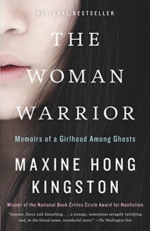The War of Art in Memoir
 Two days ago, I finished reading The Woman Warrior: Memoirs of a Girlhood Among Ghosts, Maxine Hong Kingston’s acclaimed 1976 memoir, and haven’t been able to stop thinking and writing about it since. In fact, I’ve already started re-reading in order to understand more fully why the book has so enchanted me, how the story of a woman born in America more than eighty years ago to Chinese immigrants has somehow connected me more deeply to my own story.
Two days ago, I finished reading The Woman Warrior: Memoirs of a Girlhood Among Ghosts, Maxine Hong Kingston’s acclaimed 1976 memoir, and haven’t been able to stop thinking and writing about it since. In fact, I’ve already started re-reading in order to understand more fully why the book has so enchanted me, how the story of a woman born in America more than eighty years ago to Chinese immigrants has somehow connected me more deeply to my own story.
It’s a strange book in so many ways—both haunted (as you might guess from the subtitle) and haunting. Almost immediately, Kingston diverges from her lived experience into an extended retelling of Chinese myth. She gives eye-witness-like accounts of places she’s never seen and events she wasn’t around for. And she doesn’t directly disclose much about her child-self until the final chapter. In other words, she breaks all the norms for contemporary memoir writing. As the back cover blurb proclaims, “Kingston [has] created an entirely new form—an exhilarating blend of autobiography and mythology, of world and self, of hot rage and cool analysis.”
Is this new form then a memoir? Unequivocally, yes. In fact, I’d argue that The Warrior Woman has been instrumental in shaping the memoir genre as we know it today—that is, as a form made not for the simple chronicling of our personal pasts (dramatic as they might be) but as a tool for excavating the Self found amidst and between layers of ancestral, cultural, and personal histories.
To write a memoir, you must be in turns fierce, dogged, patient, humble, kind, angry, loving, reverent, and, most important of all, self-aware. You have to be strong enough to pickaxe your way through the petrified wood of the past and deft enough to weave the most delicate strands of memory encased inside it into a cloth fine enough to hold the roiling waters of a fully lived emotional life. Kingston demonstrates these qualities and abilities throughout, nowhere more poignantly than the following passage in which she links the single image of a Chinese knot and the mytho-cultural tradition of knot-making to at least three separate strands—an admission that one of the book’s central storylines is based on hearsay, the humble suggestion that her brother’s version would be more reliable, and a self-accusation concerning her tendency to twist and embellish simple truths—a character flaw that happens to also be her greatest strength:
“His version of the story may be better than mine because of its bareness, not twisted into designs. The hearer can carry it tucked away without it taking up much room. Long ago in China, knot-makers tied string into buttons and frogs, and rope into bell pulls. There was one knot so complicated that it blinded the knot-maker. Finally an emperor outlawed this cruel knot, and the nobles could not order it anymore. If I had lived in China, I would have been an outlaw knot-maker” (163).
Here, Kingston transforms the clichéd “writing as weaving” metaphor, which I shamelessly used myself in the paragraph before, into something tighter, more intricate, more personally resonant and accurate for her specific story. This metaphor, inserted into the first page of the book’s final chapter, is Kingston’s secret method—her magic. She continually unknots her personal, familial, and cultural pasts, separates and examines the threads, then reties them into compact, complex and indescribably beautiful narrative knots—buttons that turn the plain cloth of personal experience and memory into a cloak with universal fit and appeal, frogs for reminding us that we carry our transformation within, and bell pulls that enable us to sound and resound our stories forever.
None of us have Kingston’s unique story. Few of us have anything resembling her talent. But all of us have complex personal lives worth remembering, analyzing, and sharing. Reading The Woman Warrior, I’m reminded of the essential beauty of each and every lived life and inspired by the infinite number of shapes personal narratives can take—each one contributing its original style and music to humanity’s ongoing tale.
LEARN THE ART OF MEMOIR WITH KATHIE: Kathie Collins leads the four-week, mostly asynchronous Memoir Jumpstart, which begins April 4, 2021. You’ll explore what goes into turning hard-won experiences into works of art. Instructor Kathie Collins has curated essential advice on the form from the genre’s best teachers and writers and assembled it into engaging, easy-to-grasp lessons that will inspire and prepare you to write your own. More info
ABOUT KATHIE: Charlotte Lit co-founder Kathie Collins is a writer, poet, and lifelong student of Jungian psychology. She thrives in the in-between space from which dreams, creativity, and stories emerge. Kathie is happiest when she’s sharing that space with others and delights in the process of helping students transform their lived experience into gold. Kathie co-leads and serves as a memoir coach in Charlotte Lit’s Authors Lab program. She earned her Ph.D. in Mythological Studies at Pacifica Graduate Institute, where she also serves as adjunct faculty. Kathie’s poetry has appeared in Kakalak, BibleWorkbench, Immanence, and Between. Her chapbook Jubilee was published by Main Street Rag in 2011.
